
AC 11
HP 22 (5d6 + 5; bloodied 11)
Speed 10 ft., fly 30 ft.
Proficiency +2; Maneuver DC 13
Senses blindsight 60 ft., passive Perception 10
Languages —
Echolocation. The darkmantle can’t use blindsight while deafened .
False Appearance. While motionless, the darkmantle is indistinguishable from rock.
ACTIONS
Multiattack. The darkmantle uses Darkness Aura and makes a crush attack.
Darkness Aura. A 15-foot radius area of magical darkness emanates from the darkmantle, spreading around corners and moving with it. Darkvision and natural light can’t penetrate it. If the darkness overlaps with an area of light created by a 2nd-level spell or lower, the spell creating the light is dispelled. The darkness aura lasts for 10 minutes or until the darkmantle takes damage.
Crush. Melee Weapon Attack: +5 to hit, reach 5 ft., one creature. Hit: 6 (1d6 + 3) bludgeoning damage, and the target is grappled (escape DC 13). If the darkmantle made the attack with advantage , it attaches to the target’s head, and the target is blinded and can’t breathe . While grappling, the darkmantle can only attack the grappled creature but has advantage on its attack roll. The darkmantle’s speed becomes 0, and it moves with its target.
Combat
The darkmantle lies in ambush on the ceiling, waiting until a creature comes within 10 feet. It then creates its Darkness Aura and flies to attack a victim. It flees if it fails to grapple a creature or if detached.
Legends and Lore
With a History or Nature check, characters can learn the following:
DC 10 The shape of a darkmantle’s body and the rocky texture of its skin make it indistinguishable from a stalactite, so long as it remains still.
DC 15 Before it strikes, a darkmantle surrounds itself with an aura of magical darkness. While doing so, the darkmantle relies on echolocation to find its way.
DC 20 Darkmantles are about as intelligent as dogs. They gather in flocks and can be trained to serve as guardians or hunting animals.
Darkmantles billow down from cave ceilings, creating orbs of magical darkness as they envelop and crush passing creatures in their membranous folds.
Ceiling Skulkers. A darkmantle resembles a squid with flaps of skin connecting its tentacles to form a flowing mantle. It has a conical body and soft, flexible skin that can change both color and texture, allowing it to blend in perfectly with its surroundings. When flocks of darkmantles roost upside down in pitch-black caverns, they resemble stalactites—until they take flight. They use echolocation to navigate the magical darkness they create before wrapping themselves around the heads of their prey.
Hunting Companions. Intelligent cavern denizens, such as shadow elves and cloakers, sometimes domesticate darkmantles. While a darkmantle can be trained like a falcon or hunting dog, it is not judicious in its choice of target. In settled areas, darkmantles can pose a serious threat to small pets, children, and halflings.
1–2 Indistinguishable from stalactites unless examined; ambush anything that passes by
3 Flitting around like big bats
4 Caring for a clutch of stone-colored eggs
1–3 Stalagmites and stalactites
4 A distant scream, suddenly cut off; investigation leads to a dead humanoid, such as a shadow elf
5 DC 14 Perception check: High, barely-audible squeaks
6 A drop of blood or mucus falls from the ceiling
Darkmantles lurk in caves and caverns.
CR 0–2: 1 or 2 darkmantles ; darkmantle and swarm of bats
CR 3–4: 3 to 5 darkmantles ; 2 darkmantles and 1 to 3 piercers ; darkmantle and 1d4 giant bats
Treasure 200 gp, 300 sp, blood-spattered map
